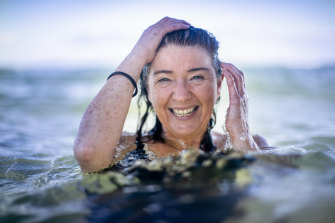How to survive winter ocean swimming as an ‘iceberger’
Whether you discovered the freedom of open water swimming in lockdown or are keen to re-frame winter into something to celebrate, there’s a lot to love about a regular dip in the cooler months.
And with the right gear, a great crew and a few post-swim warm-up tricks (whiskey anyone?), you might find yourself with a long-lasting habit.
Kate Stevens started swimming in January 2021 around the navigation poles off Edithvale, and is still maintaining the habit some 450 days later.
Kate Stevens has been winter swimming in Melbourne.Credit:Simon Schluter
“I always thought I had asthma and thought swimming would be a great way to improve my lung capacity. I also wanted to conquer something that seemed unachievable,” she says. “I decided to form the Edi Icebergers, and stood on the beach recruiting people to swim with me on Monday, Wednesday and Saturday mornings.”
Stevens says that as refreshing as a summer swim can be, it’s the winter mornings that she now lives for – and the camaraderie of her new swimming community.
“When we come out of the water, it’s the most euphoric feeling,” she says. “You think, ‘Wow, I can’t believe I’m doing this in July’. It’s freezing cold and the waves in the bay can be big like the surf coast. I have always loved the beach but now I have a brand new appreciation of it.”
While there aren’t official stats to say how many people started open water swimming during COVID, you only have to stroll along Melbourne and Sydney beaches on a winter morning to spot countless coloured swimming caps bobbing beyond the shallows.
“COVID was a bit of a forceful push,” says Andre Slade, ocean swimming coach and director of oceanswims.com.
“A lot of people found open water swimming wasn’t as bad as they thought. You get in there and think, ‘What was I so worried about? This is actually really lovely!’”
If you’re keen to give it a go, or keep the habit going as the water temperatures continue to be cold, here’s what you need to know.
While traditional icebergers might scoff at wearing a wetsuit, Slade believes they can be valuable for keeping your core temperature warm. “I’m pro-wetsuit … or pro-whatever gets people in the water and keeps them doing it,” he says.
“Wetsuits can be a good idea if your goal is distance and fitness so you can stay in the water longer, but if you just want to have a quick dip, you might be fine in your swimsuit. Not everyone enjoys wetsuits because you do lose that connection with the water.”
If you want to feel the water but stay a little more comfortable, covering your head and extremities can help.
“‘Double capping’ with two silicone caps is one of the easy secrets of keeping warm, and thermal skullcaps [made from neoprene] are the next level up,” Slade says. “Thermal gloves and thermal socks can actually be quite warm, with or without a wetsuit.”
Meanwhile, a dryrobe – or equivalent – is many winter swimmers’ on-shore uniform.
“They’re waterproof and fleece-lined so are really warm and big enough to get changed under,” Slade says.
Having people waiting for you on the beach can help get you out of bed on a fresh winter morning.
“A lot of people tell us they love swimming for the community they’ve found,” Slade says. “They tell you that as much as they love the swim, they love the coffee and the banter after too. Some groups go in the evening and have a whiskey afterwards.”
Of course, swimming in groups also has safety benefits.
“If you join a group that’s got local knowledge, you’ll pick that up from them,” Slade says. “And you’re going to have someone looking out for you.”
If you’re new to ocean dips and starting mid-winter, Slade suggests taking a slow-and-steady approach.
“Ease in when you’re getting into the water – start small and build your distance over time,” he suggests. “If it’s really cold, you could do the tea-bagger, where you get into the water and bob under the water and come out.”
If that sounds too extreme, make a plan to start next summer.
“A lot of people start in summer and keep going, conditioning themselves quite naturally to the change in water temperature,” Slade says.
“Autumn water temperatures can be some of the warmest of the year and after realising that autumn is super nice, you almost sneak into winter swimming by mistake.”
Stevens recommends slowly warming up post-swim, so rather than an immediate hot shower, she pulls on some cosy clothes and has a cup of tea.
Once you’re in a habit of ocean water swimming, Slade says you’ll find it surprisingly easy to maintain.
“Whether [you’re doing it to] conquer fears, escape something [like technology] or just be in your own space, it [offers] the biggest freedom and you get to be at one with nature,” he says.
Make the most of your health, relationships, fitness and nutrition with our Live Well newsletter. Get it in your inbox every Monday.
Most Viewed in Lifestyle
From our partners
Source: Read Full Article

